Below is another article I’d like to share in its entirety from the dailymail.com; link at the bottom. I love the Middle Ages and I love homesteading and survivalism; this this article caught my eye. Enjoy.
Jon
Could YOU live in the Middle Ages? 24-year-old spends eight months living in the freezing Russian wilderness as a medieval hermit. The project began in September and is expected to run until the end of May. Only authentic tools and food from ancient Russia are allowed.
Pavel Sapozhnikov, 24, can only leave the farm to hunt or fish for food. He can abandon the project if his life is at risk, but must stay during illness. The farm and outbuilding were built using methods from the 10th century.
By VICTORIA WOOLLASTON
PUBLISHED: 08:51 EST, 27 January 2014 | UPDATED: 14:55 EST, 27 January 2014
A Russian man is taking the chance to escape the rat race to the extreme – by living like a 10th century hermit in the snow-covered forests of Russia.
Pavel Sapozhnikov, 24, from Moscow will spend a total of eight months living like his ancestors did on a replica of an ancient farm as part of a social experiment.
He is only allowed to leave the fenced-off area of the farm to hunt and gather food, is banned from any kind of communication, and can only use authentic tools from ancient Russia.
Russian Pavel Sapozhnikov, 24, pictured, has spent the past four months living on a replica 10th century farm north of Moscow, and is expected to stay there until May this year. Sapozhnikov can only leave the farm to hunt for food and can only use tools that would have been used in ancient Russia.
A DAY IN THE LIFE OF THE ANCIENT RUSSIAN HERMIT
At the start of the project, Pavel Sapozhnikov was given the chance to document a day in the life using a camera and notepad, and this was posted on the project’s blog.
According to this blog, Sapozhnikov spends the morning milking his goats and eating breakfast.
He then chops wood for the fire and collects water from the well.
The rest of the day is spent either hunting for food, or carrying out manual labour on the farm.
This includes insulating the house with manure, maintaining his house and outbuildings, and other tasks around the farm.
To prepare for the mission, Sapozhnikov spent months learning how to prepare animals, including chickens.
He also became skilled in using the ancient tools and familiarised himself with ancient fire-building and washing techniques.
He is only allowed to leave the farm to find food, and is forbidden from any form of communication.
The farm is situated in a forest clearing around 50 miles north of the Russian capital.
It features a house, a well, hayloft and smokehouse, plus a separate toilet, and bread oven. Sapozhnikov additionally has pens for chickens and goats.
The experiment is part of a project called ‘Hero’ and was set up by events manager Alexei Ovcharenko from agency Ratobor.
The theory behind the experiment is ‘to trace the social and psychological changes in personality and learn how important the support of others is to modern humans.’
With help from expert archaeologist, Alexander Fetisov, the farm was built using only materials and techniques that would have been used by ancient Russians.
Sapozhnikov must also furnish his home in the same way.
This includes fire lights that burn on linseed oil, wooden beds, animal fur clothes and bedding and a calendar scratched into the wall of the house.
Construction on the farm began at the start of 2012, and Sapozhnikov moved in at the start of September 2013; the project is expected to run until May.
During this time, temperatures in the region can drop as low as minus 30°C and this time period was deliberately chosen to highlight exactly how difficult Russian ancestors would have found living and hunting in the conditions.
Sapozhnikov’s farm is situated in a forest clearing around 50 miles north of Moscow. It features pens for chickens, pictured, as well as goats. Chickens are used for eggs and meat, while the goats are used for milk.
With help from expert archaeologist, Alexander Fetisov, the farm was built using only materials and techniques that would have been used by ancient Russians. This includes fire lights that burn on linseed oil, wooden beds, animal fur clothes and bedding, pictured, and a calendar scratched into the wall of the house.
Disclaimer: The video is in Russian
Ovcharenko added that eight months is long enough for the experiment to yield results, but not too long that it will ‘pathologically endanger’ Sapozhnikov.
At the start of the project, Sapozhnikov was given the chance to document a day in the life on the farm, using a camera and notepad, and this was posted on the project’s blog.
According to this blog, Sapozhnikov spends the morning milking his goats, preparing his chickens, collecting eggs and eating breakfast, he then chops wood for the fire and collects water from the well.
The rest of the day is spent either hunting for food, or carrying out manual labour on the farm. This includes insulating the house with manure.
Construction of the farm, shown in this illustration, began at the start of 2012, and Sapozhnikov moved in at the start of September 2013. The fenced-off farm features a house, a well, hayloft and smokehouse, plus a separate toilet. There is also a bread oven and a bath.
Sapozhnikov spends the morning milking his goats, preparing his chickens, pictured left, and eating breakfast. He then chops wood for the fire, right, and collects water from the well. The rest of the day is spent either hunting for food, or carrying out manual labour on the farm, including insulating the house with manure.
To produce hot water, Sapozhnikov places stones in his fire stove, before putting these stones into a bucket of cold water, pictured. He then uses this water to wash his clothes, cooking utensils and himself.
As part of the project, Sapozhnikov is only allowed to leave the fenced off area to hunt and gather food.
He was given a small amount of harvested food at the beginning of the project, but this supply was not designed to last the length of the experiment.
Sapozhnikov is banned from any form of communication, except during open days, once a month, when a medical expert and project leader visit him and check on his progress.
Even when hunting, Sapozhnikov is forbidden from communicating with anyone he encounters.
The only way Sapozhnikov can abandon the project is if his mental or physical health is at serious risk, or his life is under threat.
As part of the project, Sapozhnikov, pictured, is only allowed to leave the fenced off area to hunt and gather food. He was given a small amount of harvested food, as well as chickens, pictured, at the beginning of the project, but this supply was not designed to last the length of the experiment.
To prepare for the mission, Sapozhnikov spent months learning how to prepare animals, including chickens, pictured. He also became skilled in using ancient tools and familiarised himself with ancient fire-building and washing techniques, with help from archaeologists.
However, if he contracts a common illness, such as a cold, or other diseases, such as a lung infection, Sapozhnikov will be required to carry on – as his ancestors would have done.
Sapozhnikov became a festival volunteer with Ratobor in 2010 and from May to September that year, he lived in a reconstruction of an ancient settlement, dubbed ‘beta’ for the current experiment.
He is single and was previously a student at Moscow University.
During winter, temperatures in the region can drop as low as 30°C and snow covers the ground for months. This time period and was deliberately chosen to highlight exactly how difficult Russian ancestors would have found living, and hunting, in these conditions, pictured’
How the farm house looks at night. The experiment is part of a project called ‘Hero’ and was set up by events manager Alexei Ovcharenko from agency Ratobor. The theory behind the experiment is ‘to trace the social and psychological changes in personality and learn how important the support of others is to modern humans.’
The only way Sapozhnikov, pictured, can abandon the project is if his mental or physical health is at serious risk, or his life is under threat. However, if he contracts a common illness, such as a cold, or even diseases, such as a lung infection, Sapozhnikov will be required to carry on – as his ancestors would have done.
To prepare for the mission, Sapozhnikov spent months learning how to prepare animals, including chickens.
He also became skilled in using ancient tools and familiarised himself with ancient fire-building and washing techniques.
For example, to produce hot water, Sapozhnikov places stones in his fire stove until they are glowing, before putting these stones into a bucket of cold water.
He then uses this water to wash his clothes, cooking utensils, his home, and his body – although because water is scarce, clothes and body washing is carried out ‘infrequently.’
Ratobor was set up in 2006 and has completed similar events based on historical experiences.
Sapozhnikov tracks how long he has been on the farm using a make-shift calendar scratched into the wall of the house, pictured.
http://www.dailymail.co.uk/sciencetech/article-2546660/Could-YOU-live-Middle-Ages-24-year-old-spends-eight-months-living-freezing-Russian-wilderness-medieval-hermit.html

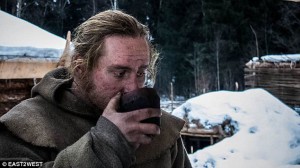
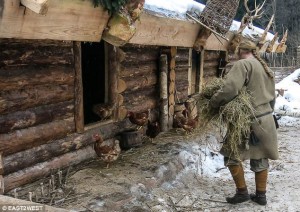
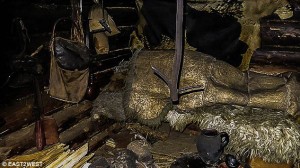
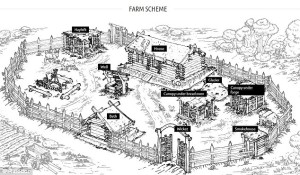
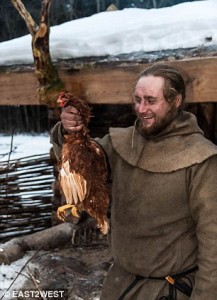
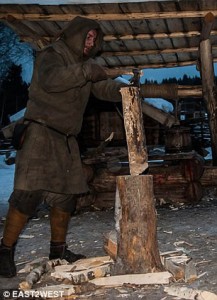
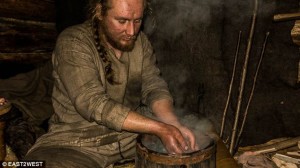

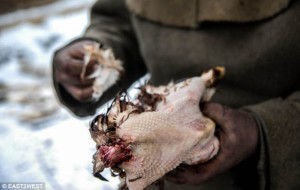
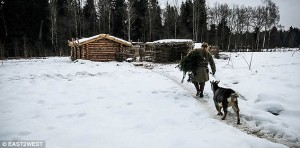
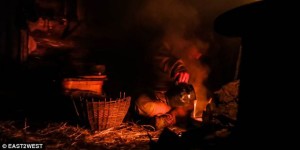
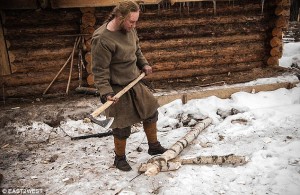
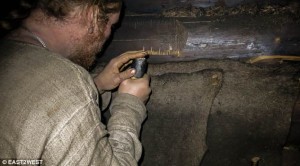
Leave a Reply